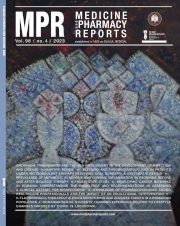Bleeding and thromboembolic risk in patients under anticoagulant therapy receiving oral surgery: a systematic review
DOI:
https://doi.org/10.15386/mpr-2519Keywords:
anticoagulant therapy, thromboembolic risk, oral surgeryAbstract
Background and aims. There is an increasing number of patients with cardiovascular diseases who require anticoagulant treatment to address the underlying disease. Types of anticoagulants include vitamin K antagonists, such as warfarin and coumarin derivatives, and also newer oral anticoagulants, including rivaroxaban, apixaban, edoxaban, and dabigatran. The use of these anticoagulants may impact the condition of patients undergoing oral surgery. If the treatment is discontinued, the patient may be at risk of thrombosis. On the other hand, if the treatment is continued, the patient may experience a postoperative bleeding episode, placing them at risk of both thrombosis and bleeding.
Method. The present article systematically reviews two different therapeutic regimens and their influence on hemorrhagic and thromboembolic events. The review included research from three databases and four specialized journals. The regimens examined were continuous versus discontinuous anticoagulant treatment and continuous versus interruption and switch to bridging therapy.
Results. The most common surgical procedure examined in the review was tooth extraction, with a few studies also including soft tissue procedures. A total of seven eligible articles were identified, with five using the first treatment regimen of continuous versus discontinuous anticoagulant. These studies reported several cases of bleeding under continuous anticoagulant treatment during surgery. Two articles used the second treatment regimen of continuous versus interruption and switch to bridging therapy.
Conclusions. The results of both treatment categories (continuous versus discontinuous anticoagulant and continuous versus interruption and switch to bridging therapy) showed no significant differences in terms of bleeding events. However, the use of scores that assess the risk of thrombosis and bleeding can assist surgeons in anticipating the degree of ostoperative complications and making informed treatment decisions.
Downloads
Published
How to Cite
Issue
Section
License
The authors are required to transfer the copyright of the published paper to the journal. This is done by agreeing to sign the Copyright Assignment Form. Whenever the case, authors are also required to send permissions to reproduce material (such as illustrations) from the copyright holder.

The papers published in the journal are licensed under a Creative Commons Attribution-NonCommercial-NoDerivatives 4.0 International License.

